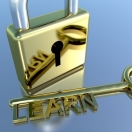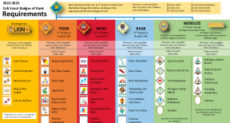 If you’re a trainer. BSA has some excellent resources on the national website, which are updated periodically. Recently they posted some helpful tips for trainers. Following are a few of them, primarily dealing with the mechanics of giving a training presentation, along with some of my own observations.
If you’re a trainer. BSA has some excellent resources on the national website, which are updated periodically. Recently they posted some helpful tips for trainers. Following are a few of them, primarily dealing with the mechanics of giving a training presentation, along with some of my own observations.
Colors – If you are using a poster, a flipchart, or a presentation graphics program, color can enhance your presentation, but used poorly can make it awful. Keep it simple and use colors with a sharp contrast. Keep in mind that about 10% of men and 1% of women have some form of color vision deficiency. Sometimes black and white is best!
Always preview color material in black & white, especially printed handouts. Don’t rely on color to distinguish or emphasize points, or use methods like “items in red are required.” A black-and-white copy of a color document will lose that information.
Tool or Script? – Too many of us create presentation media that is more like a script than a teaching tool. Slides or charts should be limited to key points to help you and your audience remember something, not be the entire content of the presentation.
Slides should emphasize the point you are speaking about, not contain the text verbatim. One of my favorite presenters, Tom Peters, can put up a slide with a single word (or even a punctuation mark) and talk about it for ten minutes.
Spelling – This is pretty basic, but far too many presentations lose their impact due to poor spelling and improper capitalization. Check your prepared presentations at least twice. If you are a poor speller do not depend on spell check for slides, posters, or handouts – and recruit an assistant to help you with any “during the presentation†writing.
There’s no excuse for incorrect spelling. Even computer spelling checkers won’t catch spelling errors where the misspelled word is the correct spelling of another word. It also won’t catch usage errors, such as there and their. When in doubt, look up the meaning of the word in a dictionary.
Small Groups – In education circles there is a spreading method of instruction based on what is called the Team Based Learning Model. It is designed to be conducted in small groups; calls for Individual and group accountability; gives team assignments that promote learning and team development; and there is frequent and immediate feedback from the facilitator. Sound familiar? The Patrol Method is effective in operating a den, troop, squad, or crew and in learning. Use it!
There is a reason the BSA recommends the use of training dens and training patrols. Members of a group can help each other comprehend material that alone may seem obscure.
Avoid “Check the Box†training – the point should be learning and to help improve the learner’s ability to deliver the intended topic, not to just get it done. Train leaders, don’t just run training courses.
Use of real-life scenarios can help students visualize what’s being taught better than just reading the script or lecturing. That’s why things like having learners plan a mock den or patrol meeting are frequently employed.
Don’t Hibernate – If you are using a computer and projector for a presentation, be sure to set it up properly to avoid interruptions and embarrassment. Some tips: be sure the computer works with the projector; check the sound; turn off your screen saver and/or hibernation; turn off automatic updates (in fact, disconnect from wireless unless that is necessary for the presentation); turn off instant messenger and e-mail programs; etc. Some operating systems have a presentation mode that will do a lot of this for you – use it! And of course – practice!!
Computers tend to do what they want to do, not what you want them to do. You might think a full run-through is a waste of time but it can point out problems that can be corrected before the students arrive. Having spare lamps, discs and cables on hand is good insurance, and having another staff member bring a duplicate computer and projector isn’t a bad idea either. Always have a “Plan  B” in case of equipment problems.
In a future article I’ll cover more of BSA’s trainer tips including content-related ideas, along with some of my own. In the meantime, good luck with your training efforts!
Image: FreeDigitalPhotos.net
This post first appeared on Bobwhite Blather.




I have developed some excellent slides for a 45 minute course on lightweight backpacking for Scouters and Scouts. I don’t use them any more.
Now, I pack two backpacks with the same packing list, one how I packed seven years ago when I started as an ASM, and one how I pack now, about half the weight.
As people gather, I have everyone try on each backpack, then we unpack them with the gear in a line and start comparing each item. I have a scale, and ask people to weigh them.
I do have a set of topics that I want to cover, but I discuss those as people are holding the gear. There is always time for questions at the end.
No one has missed the slides.